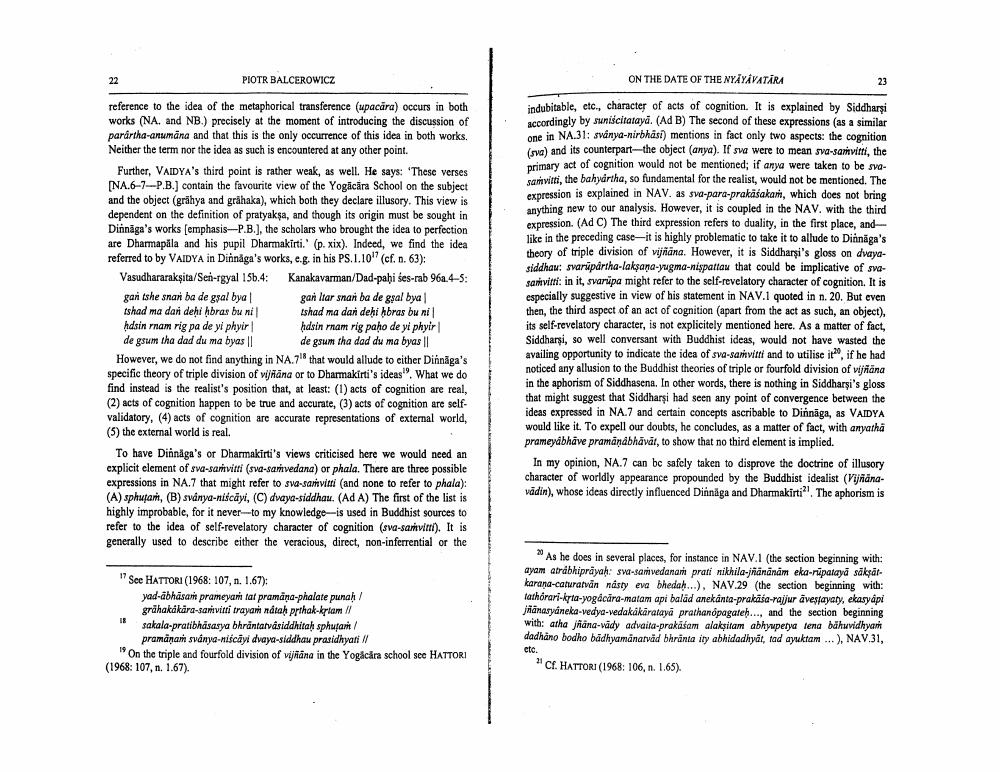Book Title: On The Date Of The Nnyayavatara Author(s): Piotr Balcerowicz Publisher: Piotr Balcerowicz View full book textPage 4
________________ PIOTR BALCEROWICZ ON THE DATE OF THE NYAYAVATĀRA reference to the idea of the metaphorical transference (upacara) occurs in both works (NA. and NB.) precisely at the moment of introducing the discussion of parartha-anumana and that this is the only occurrence of this idea in both works. Neither the term nor the idea as such is encountered at any other point. Further, VAIDYA's third point is rather weak, as well. He says: 'These verses [NA.6-7--P.B.) contain the favourite view of the Yogacara School on the subject and the object (gråhya and gråhaka), which both they declare illusory. This view is dependent on the definition of pratyakşa, and though its origin must be sought in Dinnaga's works (emphasis--P.B.), the scholars who brought the idea to perfection are Dharmapala and his pupil Dharmakirti.' (p. xix). Indeed, we find the idea referred to by VAIDYA in Dirnåga's works, c.g. in his PS.L.10" (cf. n. 63): Vasudhararakṣita/Sen-rgyal 156.4: Kanakavarman/Dad-pahi ses-rab 96a-4-5: gantshe snar ba de ggal bya gan ltar snan ba de gsal bya tshad ma dari dehi abras bu ni s had ma daldehi hbras bu ni hdsin rnam rig pa de ylphyir hdsin rnam rig paho de yi phyir de gsum tha dad du ma byas de gsum tha dad du ma byas II However, we do not find anything in NA.7' that would allude to either Dinnaga's specific theory of triple division of Hana or to Dharmakirti's ideas". What we do find instead is the realist's position that, at least: (1) acts of cognition are real, (2) acts of cognition happen to be true and accurate, (3) acts of cognition are selfvalidatory, (4) acts of cognition are accurate representations of external world, (5) the external world is real To have Dinnaga's or Dharmakirti's views criticised here we would need an explicit element of swa-samvitti (sva-samvedana) or phala. There are three possible expressions in NA.7 that might refer to sva samvitti (and none to refer to phala): (A) sphujan, (B) sványa-niscayi, (C) dvaya-siddhau. (Ad A) The first of the list is highly improbable, for it never--to my knowledge is used in Buddhist sources to refer to the idea of self-revelatory character of cognition (sVa-samvitt). It is generally used to describe either the veracious, direct, non-inferrential or the indubitable, etc., character of acts of cognition. It is explained by Siddharşi accordingly by suniscitataya. (AdB) The second of these expressions (as a similar one in NA.31: sványa-nirbhāsi) mentions in fact only two aspects: the cognition (sva) and its counterpart-the object (anya). If sva were to mean a-sanvitti, the primary act of cognition would not be mentioned; if anya were taken to be sva Samvitti, the bahyartha, so fundamental for the realist, would not be mentioned. The expression is explained in NAV. as sva-para-prakasakant, which does not bring anything new to our analysis. However, it is coupled in the NAV. with the third expression. (Ad C) The third expression refers to duality, in the first place, and like in the preceding case-it is highly problematic to take it to allude to Dinnaga's theory of triple division of vijana. However, it is Siddhari's gloss on dvayasiddhau: svarūpártha-laksana-yugma-nispattaw that could be implicative of syasanvitti: in it, svaripa might refer to the self-revelatory character of cognition. It is especially suggestive in view of his statement in NAV1 quoted in n. 20. But even then, the third aspect of an act of cognition (apart from the act as such, an object) its self-revelatory character, is not explicitely mentioned here. As a matter of fact, Siddharsi, so well conversant with Buddhist ideas, would not have wasted the availing opportunity to indicate the idea of sva-samvitti and to utilise it, if he had noticed any allusion to the Buddhist theories of triple or fourfold division of vijana in the aphorism of Siddhasena, In other words, there is nothing in Siddharsi's kloss that might suggest that Siddharsi had seen any point of convergence between the ideas expressed in NA.7 and certain concepts ascribable to Dinnaga, as VAIDYA would like it. To expell our doubts, he concludes, as a matter of fact, with anyatha prameyabhāve pramānábhāvāt, to show that no third element is implied. In my opinion, NA.7 can be safely taken to disprove the doctrine of illusory character of worldly appearance propounded by the Buddhist idealist (Vidnavādin), whose ideas directly influenced Dinnaga and Dharmakirti'. The aphorism is "See HATTORI (1968: 107, n. 1.67): yad-abhasant prameyan fat pramåna-phalate punah/ gråhakkara-saniitti trayan natah pathak-kpiam sakala-pratibhasarya bhrántarvasiddhitah sphuram pramanann sványa-niscayidveya-siddhau prasidhyati / * On the triple and fourfold division of vijana in the Yogicăra school see HATTORI (1968: 107, n. 1.67). *As he does in several places, for instance in NAV.1 (the section beginning with: ayam atrabhipraya: sva-samvedanam prati nikhilafananam eka-rüpataya sakar karana-caturalván násty eve bhedah...). NAV.29 (the section beginning with: tathórari-kyta-yogdcara-matam api balad anekanta-prakasa-rajjur avesayety, ckasyapi jinasyaneka-vedyo-vedakakarataya prathanopagateh...and the section beginning with: atha jana-vidy advaita.prakasam alaksitam abhypetye tena bdhuvidhyan dadhano bodho badhyamanarvad bhränta ity abhidadhyat, tad ayuktam ...). NAV.31, ete. CF. HATTORI (1968: 106, n. 165)Page Navigation
1 2 3 4 5 6 7 8 9 10 11 12 13 14 15 16 17 18 19 20 21
